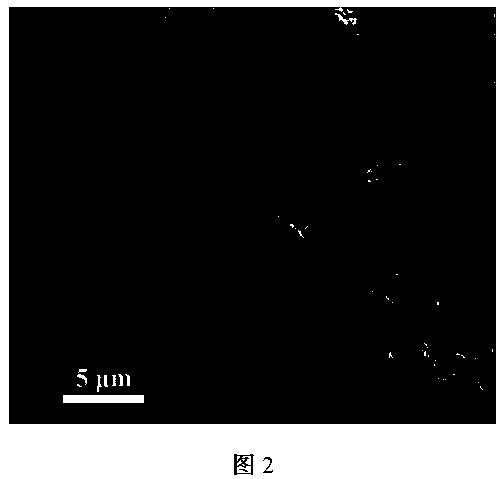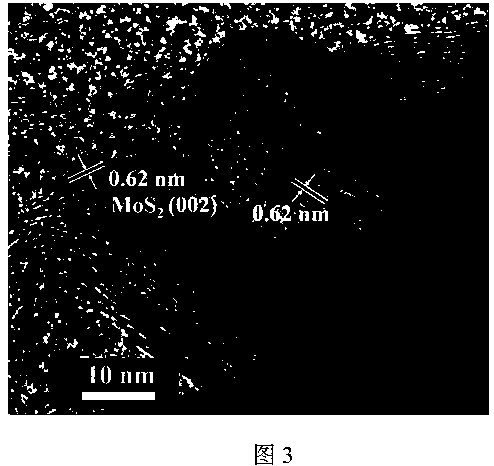MoS2-RGO-NiO@Ni foam composite photoelectrocatalytic hydrogen evolution material and preparation method thereof
A mos2-rgo-nio, composite material technology, applied in chemical instruments and methods, physical/chemical process catalysts, electrodes, etc., can solve the problems of high hydrogen evolution overpotential and poor material cycle stability.
- Summary
- Abstract
- Description
- Claims
- Application Information
AI Technical Summary
Problems solved by technology
Method used
Image
Examples
Embodiment 1
[0028] (1) Dissolve dodecamolybdophosphoric acid, methylisothiourea and polysorbate in 120mL deionized water at a weight ratio of 5:6:1 under constant stirring, and transfer the mixed solution into polytetrafluoroethylene In a lined stainless steel autoclave, hydrothermal treatment at 180 °C for 24 h, the obtained MoS 2 Wash with deionized water, centrifuge, and vacuum dry before use. (2) RGO is prepared by processing natural graphite powder with the improved Hummer method. (3) Add 18g PEG4000 into 100mL deionized water, heat to dissolve, and dissolve the MoS obtained in step (1) 2 0.4 g and 0.05 g of RGO obtained in step (2) were sequentially dispersed in PEG solution, and ultrasonically treated for 30 min to form a suspension sol. (4) Soak nickel foam in 0.2M nitric acid solution for 30min to obtain pre-oxidized NiO@Ni. (5) The NiO@Ni obtained in step (4) was immersed in the suspension sol obtained in step (3) for 2 min, then pulled at a speed of 1 mm / s and dried at 60 °C...
Embodiment 2
[0030] (1) Dissolve ammonium molybdate, thiourea and fatty acid glyceride in 120mL deionized water at a weight ratio of 4:7:1 under constant stirring, and transfer the mixed solution to a stainless steel high-pressure tank lined with polytetrafluoroethylene. In the reactor, hydrothermal treatment at 160 °C for 30 h, the obtained MoS 2 Wash with deionized water, centrifuge, and vacuum dry before use. (2) RGO is prepared by processing natural graphite powder with the improved Hummer method. (3) Add 16g PEG6000 into 100mL deionized water, heat to dissolve, and dissolve the MoS obtained in step (1) 2 0.3 g and 0.06 g of RGO obtained in step (2) were dispersed in PEG solution in turn, and ultrasonically treated for 30 min to form a suspension sol. (4) Soak nickel foam in 0.8M hydrogen peroxide solution for 50min to obtain pre-oxidized NiO@Ni. (5) The NiO@Ni obtained in step (4) was immersed in the suspension sol obtained in step (3) for 1 min, then pulled at a speed of 1 mm / s an...
Embodiment 3
[0032] (1) Dissolve sodium molybdate, vinylthiourea and sorbitan fatty acid in 120mL of deionized water at a weight ratio of 6:8:1 under constant stirring, and transfer the mixed solution into a polytetrafluoroethylene-lined In a stainless steel autoclave, hydrothermal treatment at 170 °C for 26 h, the obtained MoS 2 Wash with deionized water, centrifuge, and vacuum dry before use. (2) RGO is prepared by processing natural graphite powder with the improved Hummer method. (3) Add 20g PEG2000 into 100mL deionized water, heat to dissolve, and dissolve the MoS obtained in step (1) 2 0.5 g and 0.07 g of RGO obtained in step (2) were dispersed in PEG solution in turn, and ultrasonically treated for 30 min to form a suspension sol. (4) Soak the nickel foam in a 0.5M potassium permanganate solution for 40 minutes to obtain pre-oxidized NiO@Ni. (5) The NiO@Ni obtained in step (4) was immersed in the suspension sol obtained in step (3) for 3 min, then pulled at a speed of 1 mm / s and ...
PUM
 Login to View More
Login to View More Abstract
Description
Claims
Application Information
 Login to View More
Login to View More - R&D
- Intellectual Property
- Life Sciences
- Materials
- Tech Scout
- Unparalleled Data Quality
- Higher Quality Content
- 60% Fewer Hallucinations
Browse by: Latest US Patents, China's latest patents, Technical Efficacy Thesaurus, Application Domain, Technology Topic, Popular Technical Reports.
© 2025 PatSnap. All rights reserved.Legal|Privacy policy|Modern Slavery Act Transparency Statement|Sitemap|About US| Contact US: help@patsnap.com



